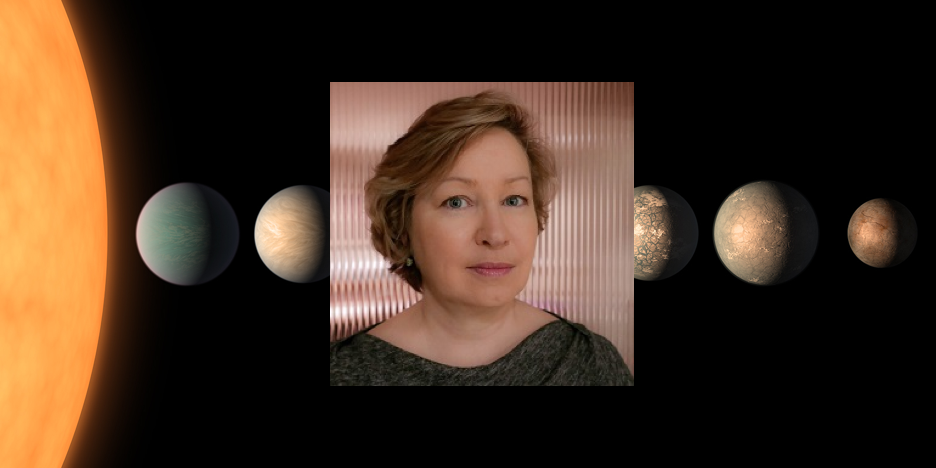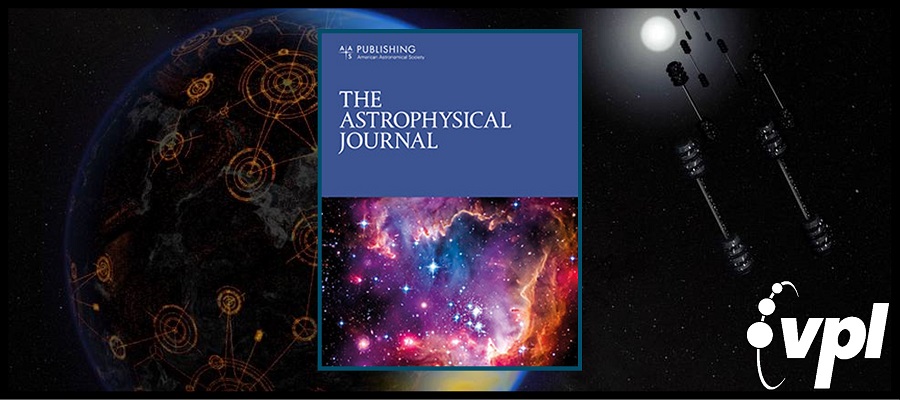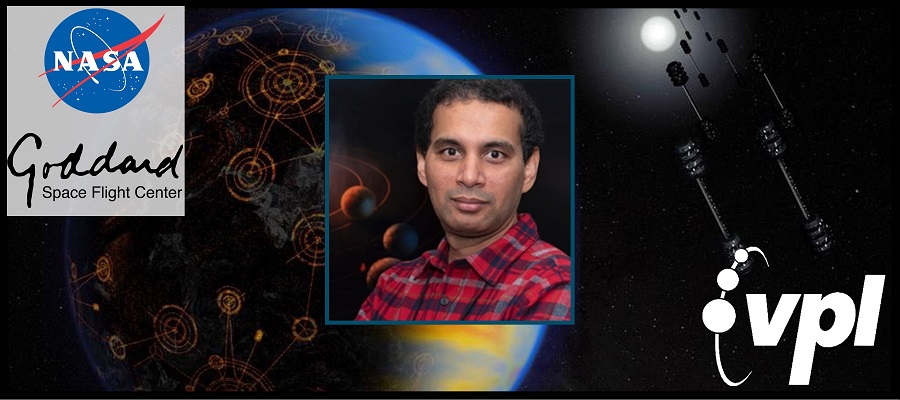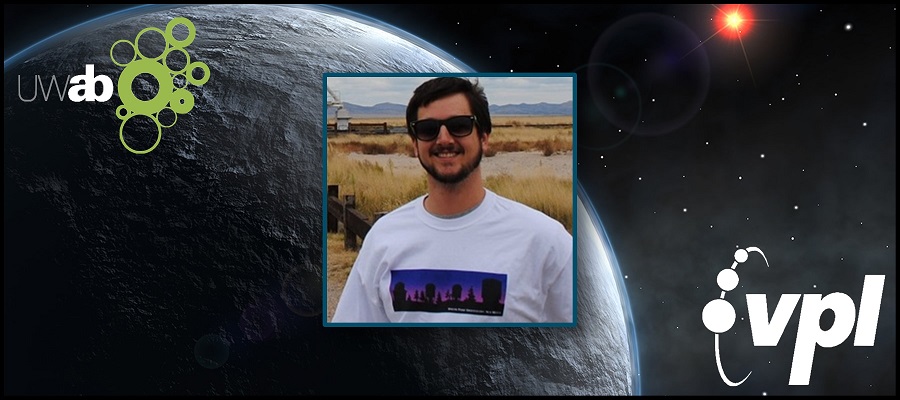The work of VPL PI Prof. Victoria Meadows was recently featured in AAS Nova. Her work, along with VPL researchers…
VPL Team members Ravi Kopparapu, Giada Arney, Jacob Haqq-Misra, and Jacob Lustig-Yaeger, recently submitted a new study for publication exploring…
Planetary atmospheres are inherently 3D objects that can have strong gradients in latitude, longitude, and altitude. Secondary eclipse mapping is a powerful way to map the 3D distribution of the atmosphere, but the data can have large correlations and errors in the presence of photon and instrument noise. We develop a technique to mitigate the large uncertainties of eclipse maps by identifying a small number of dominant spectra to make them more tractable for individual analysis via atmospheric retrieval. We use the eigencurves method to infer a multiwavelength map of a planet from spectroscopic secondary eclipse light curves. We then apply a clustering algorithm to the planet map to identify several regions with similar emergent spectra. We combine the similar spectra together to construct an eigenspectrum for each distinct region on the planetary map. We demonstrate how this approach could be used to isolate hot from cold regions and/or regions with different chemical compositions in observations of hot Jupiters with the James Webb Space Telescope (JWST). We find that our method struggles to identify sharp edges in maps with sudden discontinuities, but generally can be used as a first step before a more physically motivated modelling approach to determine the primary features observed on the planet.
Jacob Lustig-Yaeger (University of Washington, Advisor: Victoria Meadows) successfully defended his dissertation for his Dual-Title PhD in Astronomy & Astrobiology…
In the near future, extremely large ground-based telescopes may conduct some of the first searches for life beyond the solar system. High spectral resolution observations of reflected light from nearby exoplanetary atmospheres could be used to search for the biosignature oxygen. However, while Earth’s abundant O2 is photosynthetic, early ocean loss may also produce high atmospheric O2 via water vapor photolysis and subsequent hydrogen escape. To explore how to use spectra to discriminate between these two oxygen sources, we generate high-resolution line-by-line synthetic spectra of both a habitable Earth-like and post-ocean-loss Proxima Centauri b.
We investigate the potential for the James Webb Space Telescope (JWST) to detect and characterize the atmospheres of the sub-Neptunian exoplanets in the TOI-270 system. Sub-Neptunes are considered more likely to be water worlds than gas dwarfs. We model their atmospheres using three atmospheric compositions two examples of hydrogen-dominated atmospheres and a water-dominated atmosphere. We then simulate the infrared transmission spectra of these atmospheres for JWST instrument modes optimized for transit observation of exoplanet atmospheres: NIRISS, NIRSpec, and MIRI. We then predict the observability of each exoplanets atmosphere. TOI-270c and d are excellent targets for detecting atmospheres with JWST transmission spectroscopy, requiring only 1 transit observation with NIRISS, NIRSpec, and MIRI; higher signal-to-noise ratio can be obtained for a clear H-rich atmosphere. Fewer than three transits with NIRISS and NIRSpec may be enough to reveal molecular features. Water-dominated atmospheres require more transits. Water spectral features in water-dominated atmospheres may be detectable with NIRISS in two or three transits. We find that the detection of spectral features in a cloudy, H-rich atmosphere does not require integrations as long as those required for the water-dominated atmosphere, which is consistent with the differences in atmospheric mean molecular weight. TOI-270c and d could be prime targets for JWST transit observations of sub-Neptune atmospheres. These results provide useful predictions for observers who may propose to use JWST to detect and characterize the TOI-270 planet atmospheres.
Robust atmospheric and radiative transfer modeling will be required to properly interpret reflected-light and thermal emission spectra of terrestrial exoplanets. This will help break observational degeneracies between the numerous atmospheric, planetary, and stellar factors that drive planetary climate. Here, we simulate the climates of earthlike worlds around the Sun with increasingly slow rotation periods, from earthlike to fully Sun-synchronous, using the ROCKE-3D general circulation model. We then provide these results as input to the Spectral Planet Model, which employs the Spectral Mapping Atmospheric Radiative Transfer model to simulate the spectra of a planet as it would be observed from a future space-based telescope. We find that the primary observable effects of slowing planetary rotation rate are the altered cloud distributions, altitudes, and opacities that subsequently drive many changes to the spectra by altering the absorption band depths of biologically relevant gas species (e.g., ${{rm{H}}}_{2}{rm{O}}$, ${{rm{O}}}_{2}$, and ${{rm{O}}}_{3}$). We also identify a potentially diagnostic feature of synchronously rotating worlds in mid-infrared ${{rm{H}}}_{2}{rm{O}}$ absorption/emission lines.
Graduate Student Jacob Lustig-Yaeger (University of Washington) presented an invited talk on “The Era of Terrestrial Exoplanet Characterization” at the…
Near-term studies of Venus-like atmospheres with James Webb Space Telescope (JWST) promise to advance our knowledge of terrestrial planet evolution. However, the remote study of Venus in the solar system and the ongoing efforts to characterize gaseous exoplanets both suggest that high altitude aerosols can limit observational studies of lower atmospheres, and potentially make it challenging to recognize exoplanets as “Venus-like.” To support practical approaches for exo-Venus characterization with JWST, we use Venus-like atmospheric models with self-consistent cloud formation of the seven TRAPPIST-1 exoplanets to investigate the atmospheric depth that can be probed using both transmission and emission spectroscopy. We find that JWST/Mid-IR Instrument Low Resolution Spectrometer secondary eclipse emission spectroscopy in the 6 ?m opacity window could probe at least an order of magnitude deeper pressures than transmission spectroscopy, potentially allowing access to the subcloud atmosphere for the two hot innermost TRAPPIST-1 planets. In addition, we identify two confounding effects of sulfuric acid aerosols that may carry strong implications for the characterization of terrestrial exoplanets with transmission spectroscopy: (1) there exists an ambiguity between cloud-top and solid surface in producing the observed spectral continuum; and (2) the cloud-forming region drops in altitude with semimajor axis, causing an increase in the observable cloud-top pressure with decreasing stellar insolation. Taken together, these effects could produce a trend of thicker atmospheres observed at lower stellar insolationa convincing false positive for atmospheric escape and an empirical “cosmic shoreline.” However, developing observational and theoretical techniques to identify Venus-like exoplanets and discriminate them from stellar windswept worlds will enable advances in the emerging field of terrestrial comparative planetology.
coronagraph is an open-source Python package for generalized telescope noise modeling for extrasolar planet (exoplanet) science. This package is based on Interactive Data Language (IDL) code originally developed by T. Robinson (Robinson, 2018), and described in detail with science applications in (Robinson, Stapelfeldt, & Marley, 2016).
The James Webb Space Telescope (JWST) will offer the first opportunity to characterize terrestrial exoplanets with sufficient precision to identify high mean molecular weight atmospheres, and TRAPPIST-1’s seven known transiting Earth-sized planets are particularly favorable targets. To assist community preparations for JWST observations, we use simulations of plausible post-ocean-loss and habitable environments for the TRAPPIST-1 exoplanets, and test simulations of all bright object time-series spectroscopy modes and all Mid-Infrared Instrument photometry filters to determine optimal observing strategies for atmospheric detection and characterization using both transmission and emission observations. We find that transmission spectroscopy with the Near-Infrared Spectrograph Prism is optimal for detecting terrestrial, CO2-containing atmospheres, potentially in fewer than 10 transits for all seven TRAPPIST-1 planets, if they lack high-altitude aerosols. If the TRAPPIST-1 planets possess Venus-like H2SO4 aerosols, up to 12 times more transits may be required to detect an atmosphere. We present optimal instruments and observing modes for the detection of individual molecular species in a given terrestrial atmosphere and an observational strategy for discriminating between evolutionary states. We find that water may be prohibitively difficult to detect in both Venus-like and habitable atmospheres, due to its presence lower in the atmosphere where transmission spectra are less sensitive. Although the presence of biogenic O2 and O3 will be extremely challenging to detect, abiotically produced oxygen from past ocean loss may be detectable for all seven TRAPPIST-1 planets via O2O2 collisionally induced absorption at 1.06 and 1.27 ?m, or via NIR O3 features for the outer three planets. Our results constitute a suite of hypotheses on the nature and detectability of highly evolved terrestrial exoplanet atmospheres that may be tested with JWST.
Terrestrial planets orbiting M dwarfs may soon be observed with the James Webb Space Telescope (JWST) to characterize their atmospheric composition and search for signs of habitability or life. These planets may undergo significant atmospheric and ocean loss due to the superluminous pre-main-sequence phase of their host stars, which may leave behind abiotically generated oxygen, a false positive for the detection of life. Determining if ocean loss has occurred will help assess potential habitability and whether or not any O2 detected is biogenic. In the solar system, differences in isotopic abundances have been used to infer the history of ocean loss and atmospheric escape (e.g., Venus, Mars). We find that isotopologue measurements using transit transmission spectra of terrestrial planets around late-type M dwarfs like TRAPPIST-1 may be possible with JWST, if the escape mechanisms and resulting isotopic fractionation were similar to Venus. We present analyses of post-ocean-loss O2- and CO2-dominated atmospheres containing a range of trace gas abundances. Isotopologue bands are likely detectable throughout the near-infrared (18 ?m), especially 34 ?m, although not in CO2-dominated atmospheres. For Venus-like D/H ratios 100 times that of Earth, TRAPPIST-1b transit signals of up to 79 ppm are possible by observing HDO. Similarly, 18O/16O ratios 100 times that of Earth produce signals at up to 94 ppm. Detection at signal-to-noise ratio = 5 may be attained on these bands with as few as four to 11 transits, with optimal use of JWST’s NIRSpec Prism. Consequently, H2O and CO2 isotopologues could be considered as indicators of past ocean loss and atmospheric escape for JWST observations of terrestrial planets around M dwarfs.
We derive analytic, closed form, numerically stable solutions for the total flux received from a spherical planet, moon, or star during an occultation if the specific intensity map of the body is expressed as a sum of spherical harmonics. Our expressions are valid to arbitrary degree and may be computed recursively for speed. The formalism we develop here applies to the computation of stellar transit light curves, planetary secondary eclipse light curves, and planetplanet/planetmoon occultation light curves, as well as thermal (rotational) phase curves. In this paper, we also introduce starry, an open-source package written in C++ and wrapped in Python that computes these light curves. The algorithm in starry is six orders of magnitude faster than direct numerical integration and several orders of magnitude more precise. starry also computes analytic derivatives of the light curves with respect to all input parameters for use in gradient-based optimization and inference, such as Hamiltonian Monte Carlo (HMC), allowing users to quickly and efficiently fit observed light curves to infer properties of a celestial body’s surface map. (Please see https://github.com/rodluger/starry, https://rodluger.github.io/starry/, and https://doi.org/10.5281/zenodo.1312286).
The TRAPPIST-1 planetary system provides an unprecedented opportunity to study terrestrial exoplanet evolution with the James Webb Space Telescope (JWST) and ground-based observatories. Since M dwarf planets likely experience extreme volatile loss, the TRAPPIST-1 planets may have highly evolved, possibly uninhabitable atmospheres. We used a versatile, 1D terrestrial planet climate model with line-by-line radiative transfer and mixing length convection (VPL Climate) coupled to a terrestrial photochemistry model to simulate environmental states for the TRAPPIST-1 planets. We present equilibrium climates with self-consistent atmospheric compositions and observational discriminants of postrunaway, desiccated, 10–100 bar O2- and CO2-dominated atmospheres, including interior outgassing, as well as for water-rich compositions
(The Astrophysical Journal, 2018)
“A group of leading researchers in astronomy, biology and geology have come together under NASA’s Nexus for Exoplanet System Science, or…
Proxima Centauri b provides an unprecedented opportunity to understand the evolution and nature of terrestrial planets orbiting M dwarfs. Although Proxima Cen b orbits within its star’s habitable zone, multiple plausible evolutionary paths could have generated different environments that may or may not be habitable. Here, we use 1-D coupled climate-photochemical models to generate self-consistent atmospheres for several evolutionary scenarios, including high-O2, high-CO2, and more Earth-like atmospheres, with both oxic and anoxic compositions. We show that these modeled environments can be habitable or uninhabitable at Proxima Cen b’s position in the habitable zone. We use radiative transfer models to generate synthetic spectra and thermal phase curves for these simulated environments, and use instrument models to explore our ability to discriminate between possible planetary states.
We explore the occurrence and detectability of planet-planet occultations (PPOs) in exoplanet systems. These are events during which a planet occults the disk of another planet in the same system, imparting a small photometric signal as its thermal or reflected light is blocked. We focus on the planets in TRAPPIST-1, whose orbital planes we show are aligned to < 0\buildrel{\circ}\over{.} 3 at 90% confidence. We present a photodynamical model for predicting and computing PPOs in TRAPPIST-1 and other systems for various assumptions of the planets’ atmospheric states. When marginalizing over the uncertainties on all orbital parameters, we find that the rate of PPOs in TRAPPIST-1 is about 1.4 per day. We investigate the prospects for detection of these events with the James Webb Space Telescope, finding that ∼10-20 occultations per year of b and c should be above the noise level at 12-15 μm. Joint modeling of several of these PPOs could lead to a robust detection. Alternatively, observations with the proposed Origins Space Telescope should be able to detect individual PPOs at high signal-to-noise ratios. We show how PPOs can be used to break transit timing variation degeneracies, imposing strong constraints on the eccentricities and masses of the planets, as well as to constrain the longitudes of nodes and thus the complete three-dimensional structure of the system. We further show how modeling of these events can be used to reveal a planet’s day/night temperature contrast and construct crude surface maps. We make our photodynamical code available on github (https://github.com/rodluger/planetplanet).




